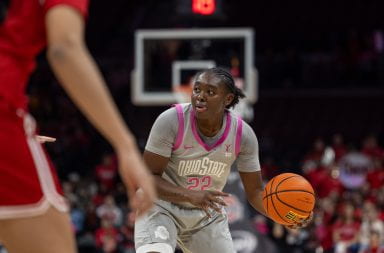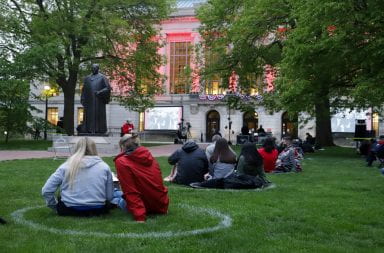
Ohio State’s seven-day average COVID-19 student positivity rate has stayed below one percent since Oct. 1. Credit: Courtesy of Ohio State
While COVID-19 cases across the state of Ohio, the U.S. and other universities have been increasing, Ohio State’s numbers have dropped and stayed there.
A report released Thursday from the university’s Comprehensive Monitoring Team, led by Dean of the College of Public Health Amy Fairchild, showed that measures to reduce COVID-19 on and off campus have been effective in controlling virus spread.
Fairchild said the entirety of COVID-19 guidelines — such as mask wearing, class and gathering size limitations, social distancing, contact tracing and quarantine and isolation housing — is why Ohio State has been successful where other universities have struggled.
“Having the environment such that infection is very unlikely because you’ve got that six-foot distance between folks, because you’ve got people wearing masks — wearing them consistently and wearing them properly — it’s that whole array of things that have made for success at OSU,” Fairchild said.
Even though Ohio State is experiencing low COVID-19 numbers, what spring semester will look like is dependent on how the pandemic progresses over winter break, with much of the university community traveling and mixing with other populations for the holidays, Fairchild said.
“Right now, we’re not imagining any huge changes to what things would look like in the spring,” Fairchild said.
Dr. William Miller, professor of epidemiology and member of the Safe Campus and Scientific Advisory subgroup of Ohio State’s coronavirus task force, said the university is uniquely positioned to control the spread of COVID-19 due to its testing program, which can’t practically be implemented for the entire state of Ohio as cases continue to rise. He said through testing and contact tracing, the university is able to curb infections by responding to a case within 24 hours.
In addition to testing, Ohio State is monitoring infection rates through weekly wastewater surveillance of on campus residences. COVID-19 presence in wastewater may signal an outbreak up to a week before residents are clinically diagnosed through testing, according to the report.
Wastewater surveillance also checks the effectiveness of existing testing measures in the event that multiple students in a residence hall falsely test negative but COVID-19 appears in their wastewater, according to the report.
“While screening tests are an active approach, wastewater testing represents a parallel passive approach that offers a floodwall in the event of major testing issues,” a university release stated. “It also offers a way of continuously performing a quality control of the active screening effort and provides a path to transition to a program with less testing or a different testing protocol when this is desirable.”
The report also included the university’s on-campus student transmission rate, which shows how many new infections a single case causes on average. A transmission rate of less than 1 means the pandemic is currently slowing.
Ohio State’s on-campus student transmission rate has remained stable and typically less than 1 since Sept. 12, according to the report.
However, Miller said the measurement is sensitive to small fluctuations in case count when the prevalence of COVID-19 is as low as it is at Ohio State. He said the measurement is more telling with a substantial number of cases.
“When you’re bouncing around with just a handful of cases each day, when you go from six to seven, it looks like an increase but it’s not really. It’s just noise,” Miller said.
The report comes two days before Ohio State Football kicks off its delayed season in a home game against Nebraska. The only spectators at the event will be family and guests of the teams.
Fairchild said while the university is concerned with off-campus gatherings for football games, the same concerns would still be present if there was no season, and it’s important for the university’s guidelines to still be followed.
“Football season or no football season, we still have the NFL, people are going to be spending more time indoors. It’s going to be important for the community to be vigilant,” Fairchild said. “This is also an opportunity to reinforce for the community that we know these things are hard, but they work. This combination of things has really worked.”
Fairchild said it is not inevitable that cooler weather, football or the cold and flu season “send us over the edge” with COVID-19. She said an earlier onset flu season in the southern United States suggests that wearing masks may impact flu season in addition to COVID-19.
“We can prevent COVID-19 from spreading and we need to hew to the things that work,” Fairchild said.


